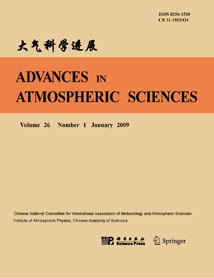| [1] |
GAO Shouting, TAN Zhemin, ZHAO Sixiong, LUO Zhexian, LU Hancheng, WANG Donghai, CUI Chunguang, CUI Xiaopeng, SUN Jianhua,
2015: Mesoscale Dynamics and Its Application in Torrential Rainfall Systems in China, ADVANCES IN ATMOSPHERIC SCIENCES, 32, 192-205.
doi: 10.1007/s00376-014-0005-x
|
| [2] |
ZHOU Xiaoping, LU Hancheng, NI Yunqi, TAN Zhemin,
2004: A Review of Major Progresses in Mesoscale Dynamic Research in China since 1999, ADVANCES IN ATMOSPHERIC SCIENCES, 21, 497-504.
doi: 10.1007/BF02915576
|
| [3] |
LI Wanli, LU Shihua, FU Shenming, MENG Xianhong, H. C. NNAMCHI,
2011: Numerical Simulation of Fluxes Generated by Inhomogeneities of the Underlying Surface over the Jinta Oasisin Northwestern China, ADVANCES IN ATMOSPHERIC SCIENCES, 28, 887-906.
doi: 10.1007/s00376-010-0041-0
|
| [4] |
Ye Zhuojia, Li Jun, Fan Sihong,
1997: Turbulent Fluxes over Inhomogeneous Landscape, ADVANCES IN ATMOSPHERIC SCIENCES, 14, 399-408.
doi: 10.1007/s00376-997-0059-0
|
| [5] |
Zhao Qiang, Liu Shikuo,
1999: Simplification of Potential Vorcticity and Mesoscale Quasi-balanced Dynamics Model, ADVANCES IN ATMOSPHERIC SCIENCES, 16, 304-313.
doi: 10.1007/BF02973090
|
| [6] |
Hui HE, Xueliang GUO, Xiang'e LIU, Qian GAO, Xingcan JIA,
2016: Mesoscale Numerical Simulation Study of Warm Fog Dissipation by Salt Particles Seeding, ADVANCES IN ATMOSPHERIC SCIENCES, 33, 579-592.
doi: 10.1007/s00376-015-5151-2
|
| [7] |
Xia Daqing, Zheng Liangjie,
1986: NUMERICAL SIMULATION OF THE GENERATION OF MESOSCALE CONVECTTVE SYSTEMS IN LARGE-SCALE ENVIRONMENT, ADVANCES IN ATMOSPHERIC SCIENCES, 3, 360-370.
doi: 10.1007/BF02678656
|
| [8] |
Jo-Han LEE, Dong-Kyou LEE, Hyun-Ha LEE, Yonghan CHOI, Hyung-Woo KIM,
2010: Radar Data Assimilation for the Simulation of Mesoscale Convective Systems, ADVANCES IN ATMOSPHERIC SCIENCES, 27, 1025-1042.
doi: 10.1007/s00376-010-9162-8
|
| [9] |
WANG Qiwei, TAN Zhemin,
2009: Idealized Numerical Simulation Study of the Potential Vorticity Banners over a Mesoscale Mountain: Dry Adiabatic Process, ADVANCES IN ATMOSPHERIC SCIENCES, 26, 906-922.
doi: 10.1007/s00376-009-8004-z
|
| [10] |
Fan Beifen, Ye Jiadong, William R. Cotton, Gregory J. Tripoli,
1990: Numerical Simulation of Microphysics in Meso-β-Scale Convective Cloud System Associated with a Mesoscale Convective Complex, ADVANCES IN ATMOSPHERIC SCIENCES, 7, 154-170.
doi: 10.1007/BF02919153
|
| [11] |
CHEN Lianshou, LUO Zhexian,
2004: Interaction of Typhoon and Mesoscale Vortex, ADVANCES IN ATMOSPHERIC SCIENCES, 21, 515-528.
doi: 10.1007/BF02915719
|
| [12] |
PENG Jiayi, FANG Juan, WU Rongsheng,
2004: Interaction of Mesoscale Convection and Frontogenesis, ADVANCES IN ATMOSPHERIC SCIENCES, 21, 814-823.
doi: 10.1007/BF02916377
|
| [13] |
Yongqiang JIANG, Yuan WANG, Chaohui CHEN, Hongrang HE, Hong HUANG,
2019: A Numerical Study of Mesoscale Vortex Formation in the Midlatitudes: The Role of Moist Processes, ADVANCES IN ATMOSPHERIC SCIENCES, 36, 65-78.
doi: 10.1007/s00376-018-7234-3
|
| [14] |
ZHOU Lingli, ZHAI Guoqing, HE Bin,
2011: Numerical Study of the Mesoscale Systems in the Spiral Rainband of 0509 Typhoon Matsa, ADVANCES IN ATMOSPHERIC SCIENCES, 28, 118-128.
doi: 10.1007/s00376-010-0023-2
|
| [15] |
Jing YANG, Gaopeng LU, Ningyu LIU, Haihua CUI, Yu WANG, Morris COHEN,
2017: Analysis of a Mesoscale Convective System that Produced a Single Sprite, ADVANCES IN ATMOSPHERIC SCIENCES, 34, 258-271.
doi: 10.1007/s00376-016-6092-0
|
| [16] |
LIU Jianyong, TAN Zhe-Min,
2009: Mesoscale Predictability of Mei-yu Heavy Rainfall, ADVANCES IN ATMOSPHERIC SCIENCES, 26, 438-450.
doi: 10.1007/s00376-009-0438-9
|
| [17] |
Li Jun, Zhou Fengxian, Gao Qinghuai,
1990: Delineation of Mesoscale Features of Ocean on Satellite IR Image, ADVANCES IN ATMOSPHERIC SCIENCES, 7, 423-432.
doi: 10.1007/BF03008872
|
| [18] |
Wanli LI, Xiushu QIE, Shenming FU, Debin SU, Yonghai SHEN,
2016: Simulation of Quasi-Linear Mesoscale Convective Systems in Northern China: Lightning Activities and Storm Structure, ADVANCES IN ATMOSPHERIC SCIENCES, 33, 85-100.
doi: 10.1007/s00376-015-4170-3
|
| [19] |
XU Zhifang, GE Wenzhong, DANG Renqing, Toshio IGUCHI, Takao TAKADA,
2003: Application of TRMM/PR Data for Numerical Simulations with Mesoscale Model MM5, ADVANCES IN ATMOSPHERIC SCIENCES, 20, 185-193.
doi: 10.1007/s00376-003-0003-x
|
| [20] |
ZHU Guofu, CHEN Shoujun,
2003: A Numerical Case Study on a Mesoscale Convective System over the Qinghai-Xizang (Tibetan) Plateau, ADVANCES IN ATMOSPHERIC SCIENCES, 20, 385-397.
doi: 10.1007/BF02690797
|















 AAS Website
AAS Website 
 AAS WeChat
AAS WeChat 
 DownLoad:
DownLoad: